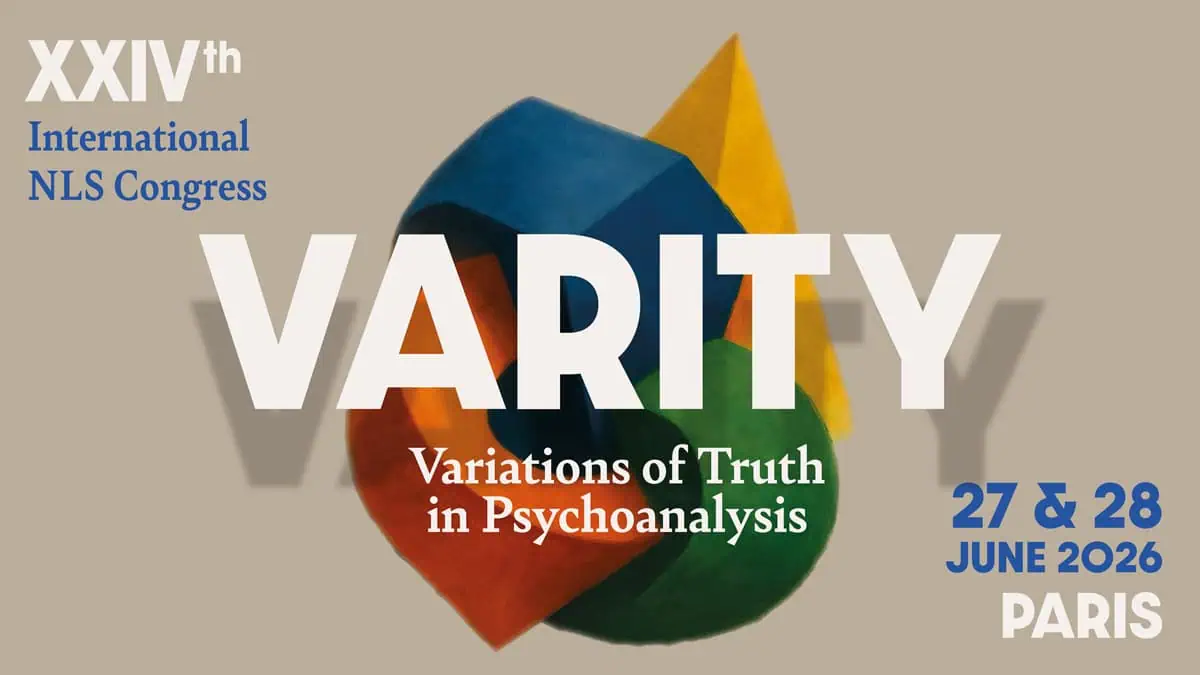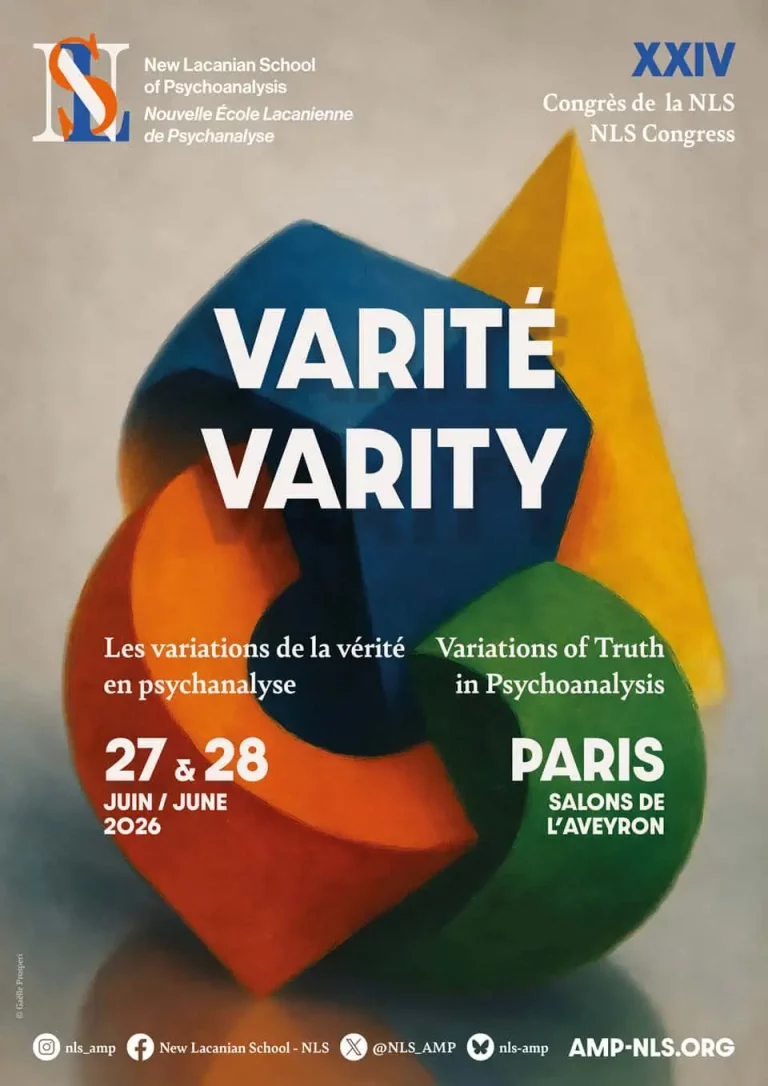By Patricia Bosquin-Caroz
VARITY
Variations of Truth in Psychoanalysis
I always say the truth: not the whole truth, because there’s no way, to say it all. Saying it all is literally impossible: words fail. Yet it’s through this very impossibility that truth holds on to the real.
Jacques Lacan, Television
The 24th NLS Congress proposes to examine the variations of truth in psychoanalysis. Lacan condensed the variations in truth that occur respective to successive revelations in an analysis into the neologism varity [varité].[1] He states that we should be open to the dimension of truth as variable, and he adds that what the analysand says is not the truth, but the vari(e)ty of the sinthome. Throughout his teaching, Lacan never abandoned the reference to truth, whether first approaching it as The truth, or later as plural, variable and lying truth. However, one constant remains: the articulation of truth, or the effects of truth, with the structure of language and speech, or even with the “language broth”.[2]
Truth, exactitude and revelation
At the beginning, Lacan highlighted a different dimension of speech than that of expression and mediation, namely the dimension of revelation. Revelation refers to the unveiling of a supposedly hidden or veiled truth and coincides with the instant of seeing. Truth thus moves from unveiling to evasion or escape, while analysis is defined as a series of revelations specific to each subject. In his founding text, “The Function and Field of Speech and Language in Psychoanalysis”,[3] Lacan opposes full speech to empty speech, full speech being the one in which the truth of the subject is realised. From this perspective, the truth of revelation concerns the truth in speech. “[It] brings us up against the reality of what is neither true nor false.”[4] Here, reality differs from any reference to exactitude and does not refer to any conformity with objective reality. The truth of the spoken word [la parole] is not based on any adequation between word and thing. Freud himself, after long research, had finally given up on the belief in the objective reality of trauma, which, in the unconscious, is indistinguishable from “fiction that has been cathected with affect”.[5] Jacques-Alain Miller put it as follows: In analysis, it is “not about saying what is”, but “about making truth out of what has been. Then there is that which was missing to make truth: traumas, that which made a hole […] It is about bringing discourse to that which could not take its place within it.”[6]
But above all, Lacan is going to situate the novelty of the Freudian discovery in relation to what irrupts in the subject’s discourse, which “normally unfolds […] within the order of error, of misrecognition, even of negation”.[7] Truth emerges from a misunderstanding, a lapsus, a bungled act, something that trips up and reveals “a truth from behind”, another meaning. It emerges in the form of a stumble that breaks the course of the subject’s narration and overtakes him. “Truth grabs error by the scruff of the neck in the mistake”.[8] It means that the subject does not know what he is saying, he always says more than he wants to say, always more than he knows how to say.
Truth, repression and history
As J.-A. Miller specifies in his text “A New Alliance with Jouissance”[9], for Lacan, an analysis first consisted for the subject in the progress of The truth, in the singular, which means that it is supposed to be inscribed in the continuity of a [hi]story [histoire]. The term “history”, as Lacan refers to it in “Function and Field of Speech and Language”, corresponds to the term “unconscious”. “The unconscious is the chapter of my history that is marked by a blank or occupied by a lie: it is the censored chapter.”[10] In analysis, the aim is to reconstitute this history. The methodical removal of repression, the lifting of the veil, enables its continuity to be restored and the hidden truth to be rediscovered. Freud’s experience with hysterics led him to not confuse biological memory with remembering [remémoration], which concerns the subject’s reconstructed history. It involves the resubjectification of the event and its retroactive restructuring. This is why Lacan first defined psychoanalysis as the subject’s assumption of its [hi]story, insofar as it is formed by speech addressed to another.
With regard to the Dora case, Lacan will use the expression “developments of truth”, that participate in the “dialectical reversals”[11] and thus in the progress of analysis. Repression and truth are thus antonyms. “[T]he concept of repression is called for, demanded, summoned by the experience of revelation”.[12] In his return to Freud, Lacan would above all reinstate the cutting edge of Freud’s discovery, which moves away from the veracity of facts. In “The Freudian Thing”, he explained that Freud’s essential discovery consisted in affirming that “it [ça] speaks, precisely where it was least expected – namely where it suffers”.[13] “I, truth, speak”.[14] Let us emphasise here, that this assertion is first and foremost of the order of an enunciation and not an egoic statement asserting a personal conviction against universal doxa.
Truth and knowledge
Lacan began by contrasting truth with knowledge and highlighting the primacy of truth over knowledge. His reference, especially to Meno’s paradox, supported the idea that “the epistêmê, knowledge bounded by a formal coherence does not cover the whole of the field of human experience.”[15] With regards to alèthès doxa, true opinion, Lacan noted that “there is here a truth, which cannot be grasped by a bounded knowledge”.[16] Like the dialectical procedure at work in the dialogue between Meno and Socrates, Lacan emphasised the creative and emergent dimension of the truth we are working with, which is not that of a preconstituted knowledge.
Reversal
Lacan will not maintain this opposition between truth and knowledge. We need to wait for his “Proposition on the Psychoanalyst of the School” to see an articulation between the two appear, formalised in the matheme of the analytic discourse. Truth and knowledge cannot be divided into two classes. “What, in its nascent moment, presents itself as truth, becomes knowledge by being registered and deposited.”[17] The Proposition of the Pass is part of this perspective of knowledge about unconscious truth. Truth first presents itself as non-knowledge, appearing through free association and eventually taking the form of a knowledge. “[I]t is articulated in chains of letters that are so rigorous that provided not one of them is left out, the un-known is arranged as the framework of knowledge”, Lacan states.[18] Lacan also establishes in terms of knowledge the mutation at work at the end of analysis, from the being of desire to that of knowledge. As we can see, it is no longer a question of the truth that says I speak, but “of a truth in chains, emptied of meaning and, by the same token, of passion”.[19] The analytical process then consists of collecting the signifiers that have a truth value, those that have counted for the subject. The analyst’s act is involved in isolating them.
Yet, Lacan would end up devaluing knowledge as a way of approaching the real. In his Seminar Encore, he speaks of “knowledge’s harebrained lucubration [élucubration] about lalangue”. The structure of language is then reduced to fiction, while the unconscious is understood as “a knowing how to do things [savoir-faire] with lalangue”.[20] So what becomes of truth? What of revelations?
Lying truth and fiction
The effects of revelation punctuate the analytic journey up to a certain point. They indicate that truth is produced in speech. This is why Lacan argued that truth has the structure of fiction. From the outset, he specified that the term fiction does not represent anything illusory or deceptive. The fictional character of myths and infantile sexual theories bears witness to this. The narrative structure of these stories allows themes such as death, existence and non-existence to be broached, in other words, the register of the unspeakable. It is also an essential dimension of the analytical experience. And yet, analysis can be pushed to the point where truth no longer applies. Jouissance is this limit point of the narrative as vehicle of the revelations. We cannot tell the truth about jouissance; nor can we tell the whole truth. In this respect, it is worth noting that Lacan constantly went against the idea of the transparency of words in relation to the Thing, or the apprehension of truth as something whole. We can only circle around it or half-say it. Consequently, the speech established by the analytic discourse is a matter of fiction, a lying truth. Language is a semblant and regarding the real, it can only lie. Freud had already noted the function of the proton pseudos in the Emma case. Lying, then, does not relate to an opposition between truthfulness and the lie.
Since his first Seminar, Lacan underlined that speech unfolds in the dimension of deceptive truth. Truth is a lie because it depends on narration, on construction, on the meaning we give to events. In his “Preface to the English Edition of Seminar XI”, Lacan evokes the term “lying truth”, a reference that could be read as a counterpoint to “Function and Field”, as J.-A. Miller had already invited us to do. Lacan thus mentions another register in which truth is no longer relevant, except as lying: that of jouissance and its satisfaction. The lying truth then becomes an elucubration of knowledge about the real, which does not prevent effects of truth from occurring and the analyst being attentive to them. “Psychoanalysis is what makes true, but how is making true [faire vrai] to be understood? It’s a stroke of meaning, a sens blanc [TN: a blank of meaning homophonic with semblant]”[21], says Lacan.
Truth, discontinuity and variation
For Lacan, truth does not go without a narrative that restores continuity to the subject’s history, giving meaning to what could not be said or that could barely be said. Narration takes “charge of what remains as a hole in the reality of the subject, and thus makes sense of his traumas, of his indelible images, of his monumental scenes”.[22] It is about re-establishing a continuity between the holes by telling a story [histoire] for someone else. But in place of the ideal of a history restored in its continuity, Lacan ended up substituting it with the concept of a discontinuous history made up of scattered bits, fragments, emergences and revelations. Narrative discontinuity puts the idea of a single, univocal truth in question again. “The very articulation of the analytical discourse leads the analysand to construct and to weave a weft of a lying, variable and changing truth, only ever transitory, incessantly toppling over into lies; and to weave this weft from past contingencies and daily contingencies”.[23]
Thus, in an analysis, one revelation follows another, sometimes calling into question the previous ones. Moreover, through its scansions and punctuations, the analyst’s act participates in the variation of truth. This is how the unconscious takes on meaning, and how that meaning is constantly reinterpreted differently. Truth varies and becomes pluralised, while hystory is to be understood henceforth as that which is constructed for another in a transferential dimension. There is no ideal continuity, but a transferential and singular history.
What is certain is that varity, the variations of truth, remains a preoccupation of psychoanalysis. In the age of post-truth, it goes against the grain of the prevailing discourse, in which reference to truth has disappeared with, as its corollary, the devaluation and even degradation of the spoken word. Our congress will thus be devoted to highlighting the ethical dimension of the relationship that subjects have with truth and with speech, which is the very condition of their analysability. “The test of truth in analysis, where one tries to say what’s true, the analyst companion being there to inspire in you a certain passion for saying what’s true.”[24]
Translation Natalie Wülfing
References
- . Lacan J., “L’insu que sait de l’une-bévue s’aile à mourre”, lesson of 19 April 1977, unpublished, “bouillon de langage”. ↑
- . Ibid. ↑
- . Lacan J., “The Function and Field of Speech and Language in Psychoanalysis”, Écrits, trans. B. Fink, Norton, London 2006. ↑
- . Ibid, p. 212 ↑
- . Freud S., The Complete Letters of Sigmund Freud to Wilhelm Fliess, 1887–1904, ed. and trans. J. M. Masson, Belknap Press, Harvard, 1985, letter of Sept. 21, 1897, p. 264; also in the Standard Edition: “Extracts from the Fliess Papers”, S.E. I, p. 260. ↑
- . Miller J.-A., “L’orientation lacanienne. Choses de finesse en psychanalyse”, lecture given at the Department of Psychoanalysis at the Université Paris 8, 18 March 2009, unpublished. ↑
- . Lacan J., The Seminar, Book I, Freud’s Papers on Technique, ed. J.-A. Miller, trans. J. Forrester, Cambridge Press,1988, p. 265. ↑
- . Ibid. ↑
- . Cf. Miller J.-A., “A New Alliance with Jouissance”, The Lacanian Review, Issue 2, ed. V. Voruz, Autumn 2016 ↑
- . Lacan J., “The Function and Field”, op. cit. p. 215. ↑
- . Lacan J., “Presentation on Transference”, Écrits, op. cit. p. 179. ↑
- . Miller J.-A., “Truth is Coupled with Meaning”, The Lacanian Review, Issue 2, op. cit, p. 12. ↑
- . Lacan J., “The Freudian Thing”, Écrits, op. cit, p. 344. ↑
- . Ibid, p. 340. ↑
- . Lacan J., The Seminar, Book II, The Ego in Freud’s Theory and in the Technique of Psychoanalysis, ed. J.-A. Miller, trans. S. Tomaselli, Cambridge Press, 1988, p. 15–16. ↑
- . Ibid. ↑
- . Miller J.-A., “Le paradoxe d’un savoir sur la verité”, La Cause freudienne, no76, December 2010, p. 124. (not available in English) ↑
- . Lacan J., “Proposition of 9 October 1967 on the Psychoanalyst of the School”, p. 5 (available on the NLS website: https://www.amp-nls.org/orientation/). ↑
- . Miller J.-A., “Le paradoxe d’un savoir sur la verité”, op. cit. p. 129. (not available in English) ↑
- . Lacan J., The Seminar, Book XX, On Feminine Sexuality, Encore, text established by J.-A. Miller, trans. B. Fink, Norton, London 1998, p. 139. ↑
- . Lacan J., “L’insu que sait…”, op. cit. lesson of 10 May 1977, unpublished. ↑
- . Miller J.-A., “Truth is Coupled with Meaning”, The Lacanian Review, Issue 2, op. cit, p.14. ↑
- . Miller J.-A., “L’orientation lacanienne. Choses de finesse en psychanalyse”, lecture given at the psychoanalysis department of the University of Paris 8, course of 11 February 2009, unpublished. ↑
- . Miller J.-A., “Pass Bis”, Psychoanalytical Notebooks, No. 17, ed. P. Dravers, 2007, p. 100. ↑





